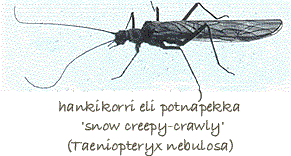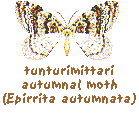
The insects, click here:
Black text in menu = not in English yet, sorry!
springtails |
mayflies |
dragonflies |
water beetles and whirligig beetles |
trichopterans |
elk fly |

The insects, click here:
Black text in menu = not in English yet, sorry!
springtails |
mayflies |
dragonflies |
water beetles and whirligig beetles |
trichopterans |
elk fly |
Typical insects of north are dark-greyish or yellow(-greenish) Plecoptera that blend well into colours of terrain. Adults are short-aged (from a couple of weeks to two months) and not very good flyers, some species, predatory as nymphs, do not even eat anything as adults. Copulation takes place on the ground in a hidden place. Only the female flies above the water when laying eggs. So usually you meet stoneflies from the vegetation - or from your clothes - where some of them like to rest.
 The shape of stonefly is elongated and a little flattened dorso-ventrally. Wings are tightly above its body when it is resting. Long antennas and cerci in some species increase its oblong impression. Their appearance is therefore quite oldish, even primitive. As a insect group Plecoptera dates back a very long time.
The shape of stonefly is elongated and a little flattened dorso-ventrally. Wings are tightly above its body when it is resting. Long antennas and cerci in some species increase its oblong impression. Their appearance is therefore quite oldish, even primitive. As a insect group Plecoptera dates back a very long time.
In Finland we have 36 species and their emphasis is clearly in north. That’s because their nymphs live in oxygen rich and cool stream waters. The earliest species Taeniopteryx nebulosa appears in early spring, when we still have snow and it is known as ‘hankikorri' (or 'potnapekka’ (see picture).
Nymph looks like an adult but it is wingless. It seeks its food from animal or plant matter, depending on the feeding habit of species. Respiration functions straight through the skin or in some species with the aid of different kind of gills at the base of legs or neck. The nymph has two cerci which is good distinguishing mark from Ephemeroptera nymph. (which looks like Plecopterans have three of them.) The life cycle of most of the species lasts only one year. Mature nymph walks to shore ground to peel off the nymphal skin.
Nymph is sensitive to the pollutants of waters and so Plecoptera species are used as indicators of pollution.

The life cycles of all Plecopteras are almost similar. The eggs develop to larvae in the water, and then they climb to land
and walk to the forest or bushes. In there they grow up and copulate. Female animals fly back to the river to lay the eggs.
 Finnish researchers (prof. E. Haukioja etc.) have been researching the ecology of autumnal carpet, for example the interaction between birch and this moth.. The earlier scientific name of autumnal carpet was Oporinia autumnata - so the researchers called it ‘opo’.
Finnish researchers (prof. E. Haukioja etc.) have been researching the ecology of autumnal carpet, for example the interaction between birch and this moth.. The earlier scientific name of autumnal carpet was Oporinia autumnata - so the researchers called it ‘opo’.
More about the damage caused by autumnal carpet!
More about the population dynamics of autumnal carpet!